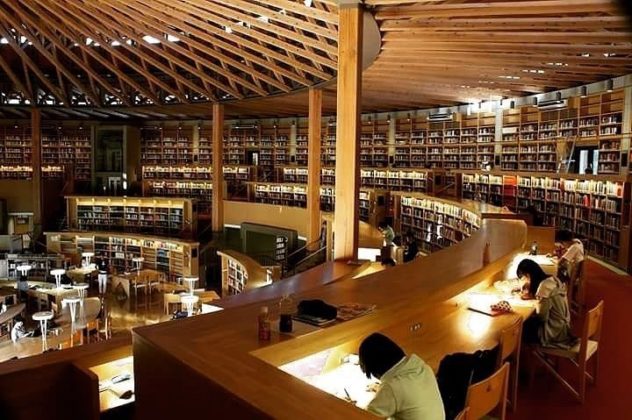© Photo by Japan Inside
Pre-Reading Questions:
- Do you like reading books?
- What is your favorite book?
Vocabulary:
- library /LAHY-brer-ee/
[noun] a building, room, or organization that has a collection, especially of books, for people to read or borrow, usually without payment
The students will go to the library to borrow books.
- history /HIS-tuh-ree/
[noun] past events considered together, especially events of a particular period, country, or subject
Ana is studying Japanese history for her final exam.
- wood /wood/
[noun] a hard substance that forms the branches and trunks of trees and can be used as a building material, for making things, or as a fuel
Hunters collected wood for the bonfire.
- roof /roof/
[noun] the covering that forms the top of a building, and vehicle
The building’s roof was painted red.
- center /SEN-ter/
[noun] the middle point or part
The tables were placed at the center for the ceremony.
An incredible public library located at Akita International University in Akita City proves its never-fading beauty from the history of Akita’s world of geisha. From AIU’s first president, Mineo Nakajima, Nakajima Library was founded in 2008.
Nakajima said “Why can’t a library, which is the heart of a university, be open 24 hours a day like a convenience store?” Through this, the so-called “library that doesn’t sleep” is open 24 hours a day, 365 days a year.
The Nakajima Library was skillfully created by architect Mitsuri Senda, who used a wooden theme for the interior design of the library. Senda made use of Akita’s cedar woods and used them to create the wooden roof and center base. The Japanese umbrella known as wagasa was used as the library’s concept.
Because of its magnificent architectural design and wonderful collections of books, this place best fits all book lovers who want to enjoy reading in a good learning environment. That’s the true beauty of Akita library and the reason why it’s called the most beautiful library in Japan.
True or False:
- Nakajima Library is the most beautiful library in Japan.
- The library is located at Kyoto International University.
- Mitsuri Senda was AIU’s first president.
- The library is open 24 hours a day, 365 days a year.
- The wooden theme was used in designing the library.
Vocabulary Check:
[noun] a building, room, or organization that has a collection, especially of books, for people to read or borrow, usually without payment
The students will go to the library to borrow books.
[noun] past events considered together, especially events of a particular period, country, or subject
Ana is studying Japanese history for her final exam.
[noun] a hard substance that forms the branches and trunks of trees and can be used as a building material, for making things, or as a fuel
Hunters collected wood for the bonfire.
[noun] the covering that forms the top of a building, and vehicle
The building’s roof was painted red.
[noun] the middle point or part
The tables were placed at the center for the ceremony.
Nakajima said “Why can’t a library, which is the heart of a university, be open 24 hours a day like a convenience store?” Through this, the so-called “library that doesn’t sleep” is open 24 hours a day, 365 days a year.
The Nakajima Library was skillfully created by architect Mitsuri Senda, who used a wooden theme for the interior design of the library. Senda made use of Akita’s cedar woods and used them to create the wooden roof and center base. The Japanese umbrella known as wagasa was used as the library’s concept.
Because of its magnificent architectural design and wonderful collections of books, this place best fits all book lovers who want to enjoy reading in a good learning environment. That’s the true beauty of Akita library and the reason why it’s called the most beautiful library in Japan.
Complete the sentences by using the words in the box.
| roof | wood | center | library | history |
- Students will go to the _____ to study.
- There is plenty of _____ from the forest.
- Bell loves to study art _____ during her college days.
- Their house’s _____ was made of stones and marbles.
- The food should be placed at the _____ for the guests to see it.
